
In a digital-first economy where seamless operations and fast customer experiences define the winners, businesses integrating Acumatica ERP with eCommerce platforms like Adobe Commerce, BigCommerce, Shopify Plus, or Magento face a pivotal decision: manage everything in-house or outsource to a seasoned managed support partner?
If you are also facing the challenges like:
| 1. Rise of omnichannel retail | 2. Real-time data expectations |
| 3. Increased complex back-office workflows | 4. Unable to access data from a mobile device |
The answer is clear: working with a specialized partner isn’t a luxury anymore; it has become a necessity for your eCommerce business.
In this blog, we’ll explore how integrating this cloud ERP with your eCommerce platform can elevate your operations and why outsourcing management to experts like DotcomWeavers is the best move for scalability, security, and sustainability.
- What is Acumatica ERP?
- Managing the Complexity in Acumatica ERP and eCommerce Integration
- Why This Complexity Requires Expert Handling
- Why Acumatica ERP and eCommerce Is a Powerful Combo
- The Reality of In-House Management
- Key Considerations for Epicor eCommerce Integration
- Choosing the Right eCommerce Platform for Epicor Integration
- Need for Managed Support Provider That Understands eCommerce Acumatica ERP Integration
- Aligning with Modern eCommerce Platforms
Let’s dive deeper into every aspect to give you a complete picture.
What is Acumatica ERP?
Acumatica is a flexible, cloud-based ERP platform for small and mid-sized businesses, designed to streamline operations across finance, inventory, sales, CRM, and more—all from a single, scalable system.
Managing the Complexity in Acumatica ERP and eCommerce Integration
In today’s fast-paced digital commerce environment, customers expect seamless, accurate, and personalized online experiences, regardless of how complex your backend systems are. This puts pressure on businesses to connect their ERP systems like Acumatica, with their eCommerce platforms (e.g., Adobe Commerce, Shopify, BigCommerce) in more advanced and intelligent ways than ever before.
What used to be a simple sync of products and orders has now evolved into a multi-layered integration effort. Let’s break down the key components that make ERP + eCommerce integration increasingly complex:
- Real-Time Product Availability
Modern buyers, especially B2B customers, demand accurate stock visibility. This means your integration must:
- Pull real-time inventory data from Acumatica, including warehouse-level stock
- Support complex inventory rules like safety stock, backorders, and pre-orders
- Reflect instant updates when stock levels change due to offline sales, returns, or transfers.
Challenge: Delayed syncs or batch updates can lead to overselling, stockouts, or customer dissatisfaction.
- Tiered Pricing Support
B2B businesses often offer different prices based on:
- Customer group or contract
- Volume ordered
- Promotions or special agreements
Your ERP typically holds these pricing rules. The integration must:
- Surface customer-specific pricing in real time on your storefront
- Adjust pricing dynamically based on quantity or user profile
- Sync promotions and discounts configured in Acumatica
Challenge: One-size-fits-all pricing on the eCommerce frontend creates friction and undermines negotiated deals.
- Customer-Specific Catalogs
Large distributors or manufacturers often restrict product visibility based on customer roles or contracts. This requires:
- Filtering catalogs by customer type or contract
- Enforcing product visibility rules from Acumatica
- Ensuring new customers or dealers are auto-assigned to the correct catalog segment
Challenge: Without automated catalog segmentation, businesses risk showing irrelevant or restricted SKUs, leading to compliance issues or a poor user experience.
4. Fulfillment & Logistics Integration
An integrated fulfillment workflow is critical for speed and accuracy. ERP-eCommerce integration should:
- Automatically push orders from the eCommerce platform into Acumatica
- Trigger pick-pack-ship workflows and sync shipping updates
- Integrate with carriers for rate calculations and tracking
- Manage multi-warehouse routing logic
Challenge: Manual re-entry of orders leads to delays, errors, and missed SLAs.
5. RMA (Returns Management) Automation
A smooth post-purchase experience requires robust RMA handling. Integration should:
- Allow customers to initiate returns directly from their account
- Sync return authorization, credit memos, and restocking updates with Acumatica
- Track RMA status and communicate updates automatically
Challenge: Manual RMA processes increase customer service costs and reduce satisfaction.
Why This Complexity Requires Expert Handling
With so many interconnected workflows—from dynamic pricing and inventory updates to customer-specific catalogs and fulfillment syncs— even a small misconfiguration in your Acumatica ERP and eCommerce integration can cause major issues. When managed in-house or through disconnected tools, the risks grow significantly:
- Breakdowns in order flows due to data mismatches or delays
- Disrupted fulfillment processes, leading to shipping errors or delays
- Lost revenue and customer dissatisfaction from incorrect pricing or stock visibility
These aren’t just technical hiccups—they’re business-critical failures that directly impact your bottom line.
That’s why forward-thinking companies are moving away from siloed solutions and seeking help from dedicated integration partners who specialize in both ERP ecosystems like Acumatica ERP and modern eCommerce platforms.
At DotcomWeavers, we’ve helped numerous B2B and B2C brands streamline these complex integrations—ensuring data flows securely, accurately, and in real time. From initial strategy to implementation and support, our team bridges the gap between ERP logic and customer-facing experiences.
Why Acumatica ERP and eCommerce Is a Powerful Combo
When seamlessly integrated, Acumatica ERP and your eCommerce platform become more than just two connected systems—they form the backbone of a unified, agile business operation. The synergy between these platforms enables:

Real-Time Inventory Sync
- Eliminate overselling or stockouts by syncing inventory across all sales channels instantly.
- Reflect inventory movements from returns, purchase orders, or transfers directly in your eCommerce frontend.
- Enable warehouse-level inventory visibility for multi-location operations.
Flow Designer
- Eliminate overselling or stockouts by syncing inventory across all sales channels instantly.
- Reflect inventory movements from returns, purchase orders, or transfers directly in your eCommerce frontend.
- Enable warehouse-level inventory visibility for multi-location operations.
Cross-System Customer Insights
- Combine ERP transactional data with eCommerce behavior analytics to get a 360° view of each customer.
- Tailor offers, pricing, and catalog visibility based on account history, industry, or region.
- Enable smarter marketing and sales strategies using centralized, real-time data.
Automated Tax, Pricing & Accounting
- Pull customer-specific pricing, volume discounts, and tax rules directly from Acumatica into your storefront.
- Auto-generate invoices, sync payments, and reconcile accounts across platforms.
- Simplify compliance with tax automation tools like Avalara via Acumatica’s integration ecosystem.
A connected Acumatica + eCommerce setup not only enhances operational efficiency but also creates the foundation for scalable, personalized digital commerce, especially for growing B2B or hybrid businesses.
The Reality of In-House Management
On paper, managing ERP + eCommerce integration in-house may seem cost-effective or controllable. But in practice, it comes with significant limitations that surface quickly, especially as your business scales or your operational needs evolve.
Limited Technical Expertise
- ERP systems like Acumatica involve deep configuration and API knowledge that internal teams may lack.
- eCommerce platforms constantly evolve—keeping up with both requires specialized, ongoing expertise.
Compatibility Challenges
- Plug-and-play integrations rarely meet complex business rules (e.g., custom pricing logic, warehouse automation).
- Updates on either platform can break integrations without proper monitoring or proactive maintenance.
Lack of Monitoring & Support
- Without 24/7 monitoring, small issues can spiral into major order disruptions or accounting mismatches.
- Internal IT teams often juggle multiple responsibilities, leaving little bandwidth for proactive integration upkeep.
Hidden Costs of In-House Complexity
- Time lost in troubleshooting, managing manual workarounds, and firefighting system errors adds up.
- Over the long term, the total cost of ownership often exceeds that of working with a qualified integration partner.
At this point, many businesses realize the smarter move is partnering with a firm like DotcomWeavers, where ERP-eCommerce integration is not just a service—it’s a core strength. With deep expertise in both Acumatica and leading eCommerce platforms, we help brands avoid technical pitfalls, reduce operational drag, and build systems that scale with confidence.
Key Considerations for Epicor eCommerce Integration
Successful Epicor eCommerce integration is more than just connecting systems. It requires thoughtful planning, testing, and collaboration. Here’s what you should keep in mind:
1. Data Clean-Up
Before integration, audit your product, customer, and order data in Epicor. Inconsistencies in SKU naming, pricing, or units of measure can cause sync errors.
2. Map Business Rules
Work closely with your eCommerce integration partners to define your business rules—pricing logic, order routing, customer hierarchies, taxes, and shipping conditions.
3. Testing and QA
Never skip the sandbox. Set up a test environment and validate all critical flows: product sync, price display, checkout, order placement, and fulfillment.
4. Staff Training
Ensure your internal teams (sales, fulfillment, customer service) understand how data flows between systems and where to look in case of issues.
5. Ongoing Support and Optimization
Epicor eCommerce integration is not “set it and forget it.” Maintain version updates, monitor for sync failures, and continuously optimize performance.
Choosing the Right eCommerce Platform for Epicor Integration
While unification methods are a critical part of the Epicor eCommerce integration strategy, it’s equally important to choose the right eCommerce platform before planning the actual integration. The platform you select shapes your site’s capabilities, performance, scalability, and user experience, especially when paired with a powerful ERP like Epicor.
For Epicor eCommerce ERP integration, users generally consider four primary choices, each with distinct advantages depending on their industry, technical needs, and business goals:
1. Epicor Commerce Connect (ECC)
ECC is a native Epicor eCommerce solution, designed to integrate directly with Epicor Kinetic (and partially with older versions). Built on the Magento eCommerce platform, ECC provides tight Epicor eCommerce integration, enabling more seamless data exchange. It includes pre-configured connections for inventory, orders, customers, and pricing.
However, ECC’s capabilities are most effective within Epicor’s ecosystem. This eCommerce integration can be limiting in terms of frontend flexibility, UX customization, or third-party integrations when compared to modern standalone eCommerce platforms.
Best suited for: Businesses already on Kinetic seeking an Epicor-backed solution with minimal custom development.
2. Popular eCommerce Frameworks
Platforms like Adobe Commerce, Magento Open Source, BigCommerce, and Shopify Plus offer powerful alternatives to ECC, especially for brands that prioritize modern UX, marketing flexibility, mobile responsiveness, and omnichannel support.
- Adobe Commerce (formerly Magento Commerce) is highly customizable and the right choice for complex B2B/B2C operations. It supports advanced pricing rules, customer segmentation, and headless commerce.
- Magento Open Source offers many of the same capabilities without licensing fees, making it a popular choice for growing businesses.
- BigCommerce delivers strong B2B features out of the box, with native support for punchout catalogs, price lists, and multi-storefront management.
- Shopify Plus is known for ease of use, fast go-to-market capabilities, and a rich third-party app ecosystem, well-suited for D2C businesses or simple B2B operations.
Above eCommerce platforms also offer more flexibility for Epicor eCommerce integration through APIs or middleware while providing freedom to shape the storefront experience and support third-party tools.
Best suited for: Businesses that require custom UX, advanced marketing tools, or headless capabilities alongside Epicor ERP.
3. Custom-Built eCommerce Platforms
For businesses with highly specific workflows, data models, or branding requirements, a custom-built eCommerce platform may be the preferred approach. These builds are typically designed from scratch (or with the help of frameworks like Laravel, React, or Vue) to match unique operational needs that off-the-shelf platforms may not support.
With Epicor as the backend system, a custom front-end provides complete control over functionality, user experience, and performance optimization. However, this approach demands a higher upfront investment and long-term maintenance resources.
Best suited for: Large enterprises with specialized processes, non-standard catalogs, or unique customer interactions.
Need for Managed Support Provider That Understands eCommerce Acumatica ERP Integration
Integrating Acumatica ERP with your eCommerce platform isn’t a set-it-and-forget-it job—it’s an ongoing process that involves syncing real-time data, adapting to platform updates, and aligning custom workflows across systems. While some teams try to manage this internally, the complexity often leads to delays, errors, and inefficiencies.
That’s where a managed support provider with a strong grasp of eCommerce operations and Acumatica workflows adds real value. Rather than managing Acumatica itself, the right partner focuses on keeping your integration ecosystem optimized, secure, and adaptable to change, so your business runs smoothly, even as platforms evolve.
In-House Management: Hidden Challenges
Manual Processes
- Prone to human error
- Time-consuming data entry and reconciliation
Reactive Monitoring
- Problems are detected only after disruption
- No automated alerts or failure handling
Limited ERP-eCommerce Expertise
- General IT teams may lack insight into Acumatica workflows
- Struggles with eCommerce-specific use cases like tiered pricing, RMAs, or tax rules
Risky Platform Updates
- New ERP or eCommerce versions may break integrations
- No staging environments or version control
Aligning with Modern eCommerce Platforms
DotcomWeavers specializes in integrating Acumatica ERP with the world’s most powerful and widely adopted eCommerce platforms—creating a unified, efficient, and scalable digital commerce experience. Our deep technical expertise and platform partnerships ensure that your ERP and storefront work seamlessly together, no matter which technology stack you choose.
Adobe Commerce
- Enterprise-grade flexibility with extensive B2B and B2C features
- Headless commerce-ready for omnichannel experiences and custom frontends
- Advanced capabilities like shared catalogs, customer segmentation, and workflows
- Seamlessly connects with Acumatica for complex pricing models, warehouse logic, and multi-site management
Perfect for mid-to-large businesses with custom workflows, multiple storefronts, and enterprise integrations.
Magento Open Source
- A cost-effective and highly customizable platform with a strong developer ecosystem
- Ideal for businesses that need flexibility without the overhead of enterprise licensing
- Supports Acumatica integration for real-time order sync, product updates, and customer management
- Easily extendable for features like tiered pricing, custom checkout flows, and shipping logic
Best for growing brands that want full control over their tech stack on a budget.
BigCommerce
- A platform with strong native support for B2B features (e.g., company accounts, bulk pricing, quote management)
- Offers flexible API architecture for seamless Acumatica integration
- Ideal for merchants who want to reduce maintenance overhead while still supporting complex operations
- Excellent for hybrid businesses selling across retail and wholesale channels
Great fit for distributors or manufacturers who want out-of-the-box B2B capabilities with room to grow.
Shopify Plus
- A high-performance platform focused on speed, simplicity, and scalability
- Built for omnichannel commerce with robust support for POS, social commerce, and marketplaces
- DotcomWeavers connects Shopify Plus with Acumatica to sync inventory, orders, fulfillment, and financials in real time
- Low maintenance, highly intuitive, and great for rapid deployment
Ideal for fast-scaling D2C or hybrid brands that prioritize ease of use and go-to-market speed.
Whether you’re a B2B supplier looking for granular ERP control or a fast-moving brand scaling across channels, DotcomWeavers helps you align Acumatica ERP with the right eCommerce platform—so your business runs lean, smart, and ready for the future.
To sum up,
You need more than just Acumatica ERP and a solid eCommerce platform. You need a managed services partner who understands the intricacies of both and ensures they work in harmony.
DotcomWeavers is that partner.
Let’s talk.
Explore how our expertise in Acumatica managed services and modern commerce platforms can accelerate your digital growth.
Receive a Personalized Consultation for Your eCommerce Requirements!
Receive a Personalized Consultation for Your eCommerce Requirements!

